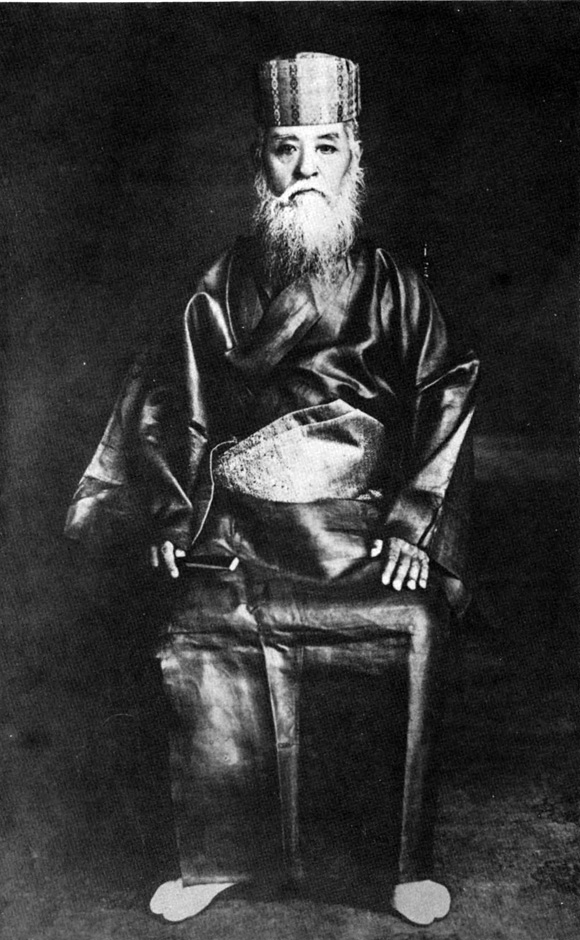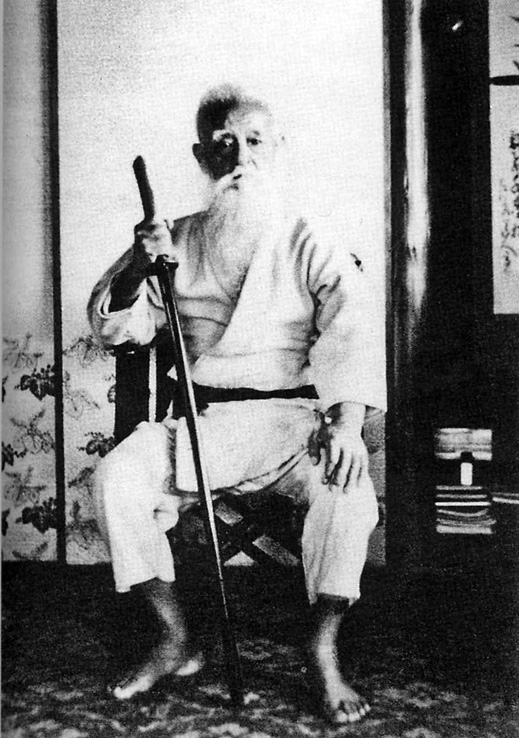(from Japanese Wikipedia, translation by Andreas Quast)

Yoshimura Chōgi (1866-1945) was born in the closing years of the Ryūkyū Kingdom as a member of the royal family of Ryūkyū. He was the 4th head of the Yoshimura Udun. He is known as a good calligrapher and painter, and also as a karate practitioner.
Life
Yoshimura Chōgi was born in Shuri Akabira village (today’s Naha City Shuri Akabira-chō) on 1866-09-27 as the 2nd son of the 3rd head of the Yoshimura Udun, Yoshimura Aji Chōmei. His Chinese-style name was Shō Meitoku, and his artist name was Jinsai, and otherwise Jutoku. His childhood-name was Umikame. The Yoshimura Udun was a Ryūkyū royal family that originated from Yoshimura Ōji Chōgi, the 3rd son of King Shō Boku (1739-1794). It was a daimyō house that owned the Kochinda district (today’s Yaese-chō Kochinda district) for generations. His father, Chōmei, was a central figure of the stubborn party (gankotō; anti-Japanese faction), who, in 1896 fled to Qing China together with his eldest son, Chōshin, to petition for Ryūkyū’s independence at the imperial Qing court. Chōgi’s mother, Makamado, was the eldest daughter of Ie Ōji Chōchoku (1818–1896, aka Shō Ken, Ryūkyūan chief envoy to the Meiji court in 1872) of the Ie Udun. In addition, Chōgi was the cousin of Motobu Chōki of the Motobu Udun [1].

Yoshimura Chōgi said, “As the second son of a powerful family, I grew up in an extensive residence, where I was served by many attendants and could act as I wished,” [2] and he began learning karate from the age of 11 or 12. His first teacher, an old man who served as an accountant and administrator of the Yoshimura Udun, taught him Naifanchi and Passai. At the age of 17 or 18, together with his older brother Chōshin, he studied under Matsumura Sōkon from Shuri, and learned the kata of Gojūshiho, Kūsankū, as well as bōjutsu (staffmanship) and kenjutsu (swordmanship).
Since the age of 22 or 23, he also studied under Higaonna Kanryō from Naha. First he went from Shuri to Naha three times a month, but later received instruction from Higaonna at the Yoshimura residence in Shuri, where he learned Sanchin and Pecchūrin.
He also studied horsemanship since around the age of 10, and from the age of 19 to 23 he studied with Makiya, a famous master of horsemanship. He said that he had a wooden horse at his residence and with it first practiced the kata (method), and afterwards practiced it with a real horse at the Shikina-en gardens.
Due to the political exile of his father and older brother, Chōgi succeeded as the head of the Yoshimura Udun in 1897 (Meiji 30). After that, his father, Chōmei died in Fuzhou in 1898 (Meiji 31) and his brother, Chōshin died abroad in 1906 (Meiji 39). In 1898 (Meiji 31), after having inherited the Yoshimura House, due to his father’s political exile, the Meiji government stopped Chōgi’s provisions of hereditary stipends. Perhaps because of this, he started a business the same year as a tea merchant and imported Chinese tea, and in 1904 (Meiji 37) he established a company to manufacture Panama hats.
In his later years, he moved to Tokyo and Osaka, where he lived the lifestyle of a literary person, enjoying calligraphy, karate, and sanshin.
On March 14, 1945 (Shōwa 20), he died in Osaka during an air raid. His age of death was 80 years.
In 1979 (Shōwa 54), about fifty paintings and calligraphic works of Chōgi were donated by his bereaved family to the Okinawa Prefectural Museum, and in 1981 (Shōwa 56), the museum held the “Yoshimura Chōgi Exhibition.”
Footnotes
- In “A fisheye lens” (Okinawa Times article on September 2, 2009), Miyagi Tokumasa states in the introduction, “Yoshimura Chogi, a cousin of Motobu Choki, was a master of karate. He enjoyed writing and was a man of both literary and martial arts (bunbu ryodo), as required from young man from the shizoku class of the Kingdom era.”
- Yoshimura Nisai: Jiden Budōki. Gekkan Bunka Okinawa, September 15, 1941; in the pictured book “Yoshimura Chōgi Ten”)
Bibliographical references
- Zuroku “Yoshimura Chōgi Ten.” Okinawa Kenritsu Hakubutsukan, 1981.
- Takamiyagi Shigeru, Shinzato Katsuhiko, Nakamoto Masahiro: Encyclopedia of Okinawa Karate Kobudō (Okinawa Karate Kobudō Jiten), Kashiwa Shobō, 2008. ISBN 978-4760133697
Related items
- Yoshimura Udun
- Karate
- Shuri-te
- Naha-te
© 2020, Andreas Quast. All rights reserved.
